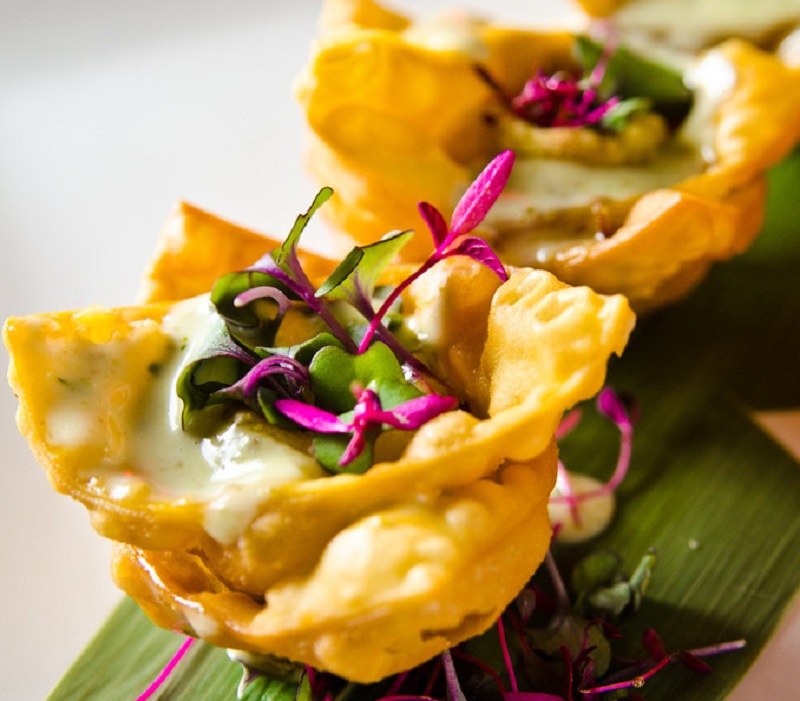Go to a Chinese restaurant on a Sunday afternoon and you will be greeted by a sea of Chinese families spanning three generations. Dim sum is the Chinese equivalent of French hors d’oeuvres or Spanish tapas. It’s a colourful and loud dining experience starting with the rush for vacant seats and the hustle and bustle of the gesticulating waiters selling specials from their trolleys.

Dim sum is an overwhelming introduction to the Chinese nation’s love of food, gregariousness and cheerful chatter. There are over 2,000 dishes to choose from. The range of cooking skills required to make dim sum is immense. There is usually a dim sum master overseeing their section of the kitchen and there is real art involved in making the dishes. Some dishes are steamed, others are fried and some are baked. The variety of tastes is also mind-boggling: sweet, sour, savoury, bitter, spicy and umami.
These are one of my favourite dim sum. You can fill the wontons with any filling of your choice. I prefer using prawn as it makes the wontons light when fried. I like to add a flamboyant tail to the pastry, which can then be dipped in the sweet and sour sauce.
This recipe was supplied by the Tse Sisters from the renowned Sweet Mandarin restaurant in Manchester. You can check out more delicious recipes from their cookbook.
| | Print Recipe |
 Dim sum is an overwhelming introduction to the Chinese nation’s love of food, gregariousness and cheerful chatter. There are over 2,000 dishes to choose from. The range of cooking skills required to make dim sum is immense. There is usually a dim sum master overseeing their section of the kitchen and there is real art involved in making the dishes. Some dishes are steamed, others are fried and some are baked. The variety of tastes is also mind-boggling: sweet, sour, savoury, bitter, spicy and umami. These are one of my favourite dim sum. You can fill the wontons with any filling of your choice. I prefer using prawn as it makes the wontons light when fried. I like to add a flamboyant tail to the pastry, which can then be dipped in the sweet and sour sauce. This recipe was supplied by the Tse Sisters from the renowned Sweet Mandarin restaurant in Manchester. You can check out more delicious recipes from their cookbook.
|
| Servings | Prep Time |
| 2 makes approx 20 | 25 minutes |
| Cook Time |
| 10 minutes |
|
|
Ingredients
- 200 g raw peeled king prawns, minced
- 200 g minced pork
- ½ tsp Salt
- ½ tsp sugar
- ½ tsp Sesame oil
- 1 tbsp potato starch
- 25 ml Water
- vegetable oil for deep frying
Instructions
- Put the prawns and minced pork in a bowl and season with salt, sugar and sesame oil. Add the potato starch and water and mash well with a fork until well blended – you’re looking for the texture of a sticky paste with some texture.
- Put 1 teaspoon of the filling into the centre of each wonton skin. Using your index finger, dampen one corner of the pastry and fold over into a triangle. To seal the edges, pleat them together to give a wavy edge.
- To cook the wontons, fill a wok with approx. 100ml vegetable oil and preheat over a medium heat to 180°C. To test the temperature, see page 35. Lower the wontons into the hot oil and deep-fry for 5 minutes until golden brown. Drain on kitchen paper and serve with sweet and sour sauce.
Deep Frying
- Many Chinese recipes are deep-fried, but the question I am often asked is how hot should the oil be? Sometimes you can feel the heat radiate from the wok, but does that mean it is hot enough? Here are some tips: If you can see smoke, the oil is too hot – your food will burn quickly on the outside and could end up raw in the centre. If the oil is too cool, the food will soak up the oil like a sponge and it will turn out greasy. For most of the recipes in this book, the oil should be at 180°C. If you don’t have a thermometer, here is a simple test. Take an unpainted, natural bamboo chopstick and dip it into the oil. If it bubbles rapidly around the chopstick end in the oil, then the oil is hot enough for deep-frying. At this stage reduce the heat to low.
Notes
Article provided by Nee Hao

